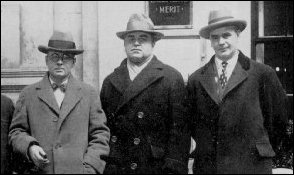
John L. Lewis' printed signature and the UMWA seal John L. Lewis was president of the UMWA from 1920-1960. He was a giant among American leaders in the first half of the twentieth century, regularly advising presidents and challenging America's corporate leaders. His work to organize the country's industrial workers through the Congress of Industrial Organizations (CIO) in the 1930s helped raise living standards for millions of American families. In the first year of the CIO, nearly four million workers joined labor organizations and wages were raised by over a billion dollars. Lewis sent hundreds of UMWA organizers to help create some of the nation's leading labor unions, including the United Steelworkers of America (USWA), the United Auto Workers (UAW), the Communication Workers of America (CWA) and many other important labor organizations that continue to speak in behalf of America's workers. Perhaps Lewis' greatest legacy was the creation of the UMWA Welfare and Retirement Fund in a contract with the federal government, signed in the White House with President Truman in attendance. The UMWA Fund would change permanently health care delivery in the coal fields of the nation. The UMWA Fund built eight hospitals in Appalachia and established numerous clinics. Upon his retirement in 1960, Lewis was awarded the Presidential Medal of Freedom, the nation's highest civilian decoration, by President John Kennedy. He remained Chairman of the UMWA Fund until his death in 1968.

Lewis is shown with UMWA vice-president Phil Murray (at right) and UMWA secretary-treasurer Thomas Kennedy (at left) during the 1925 anthracite negotiations. United Mine Workers of America is a labor union composed of coal miners and workers in coal-related industries; public employees; health-care workers; and manufacturing employees. Leaders are elected directly by members. The UMWA was organized on January 25, 1890, and was originally a member of the American Federation of Labor (AFL). Under the leadership of its president, John L. Lewis, it was one of eight unions that left the AFL in 1935 to form the Committee for Industrial Organization, later the Congress of Industrial Organizations (CIO). In 1942 the UMWA withdrew from the CIO. The UMWA suffered internal dissension in the late 1960s, with some members charging the national leadership with corruption. Running as a reform candidate for the presidency in 1969, Joseph A. Yablonski was defeated by W. A. (Tony) Boyle. In January 1970, Yablonski, his wife, and his daughter were murdered. A federal court overturned the election results; in a new election in late 1972, Boyle was defeated by another reform candidate, Arnold R. Miller. Boyle was later convicted of having ordered the Yablonski murders. In 1989 the UMWA was affiliated with the AFL-CIO. The union, with a membership of about 220,000, is divided into 16 districts in the U.S. and Canada. Each district is represented by a member on the executive board, which constitutes the organizational authority. International officials are elected for 5-year terms. The main headquarters is in Washington, D.C.








